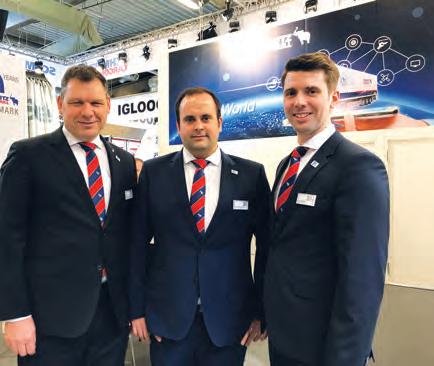
4 minute read
EVENT REVIEW
TRANSPORT 2019:
VISITORS FROM ALL OVER SCANDINAVIA
THE MESSE CENTER IN THE MID-DANISH TOWN OF HERNING HOSTED THE TRANSPORT SHOW 2019, ATTRACTING A NUMBER OF VISITORS AND EHIBITORS. [ Story by Tim de Jong ]
The Transport show in Herning, which was held 21-23 March, gathered visitors from all Scandinavian countries and the north of Germany. While the show has been around since 1988, it hasn’t really attracted the ‘big shots’ from the trailer world until now.
Trailer building juggernaut Schmitz Cargobull has come a long way since its humble beginnings. Way back in 1989 it had a modest office pavilion and used a container as a spare parts warehouse in Padborg on the Germany border. Three decades later, the OEM has firmly established itself in Denmark.
“Product innovations such as the galvanised and bolted chassis, the company’s own axle unit and most recently, its own cooling unit, have always been very well received by our Danish customers,” according to Schmitz Cargobull Director – Northwest Europe, Gregor Rein.
Schmitz Cargobull Managing Director, Tim Warmeling, explained that the Danish transport industry often plays pioneering role in telematics as well. “The openness for new technology and services is an essential part of our success story in the Danish market.”
The Danish had some impressive heavy vehicles on display, too. B-Doubles are approved to run on their roads just like elsewhere in Scandinavia and in The
Schmitz Cargobull were in Herning to discuss telematics and the trailer builder’s latest developments.

Netherlands. Operators in both countries are frustrated, though, about the reluctant attitude of their neighbour Germany versus heavier and longer combinations though.
Should the Germans allow longer combinations up to 25.25 metres up to weights of 60 tonnes, many trucks would be taken off the road in Germany. It’s a point
the Germans don’t really see – afraid as they are of allowing heavier combinations on their numerous bridges. Now, Swedes, Danes and the Dutch have to decouple at the German border or drive with significantly lower weights of just 44 tonnes to cross the largest transit country of the European continent.
Danish sources estimate that Denmark now runs between 400 and 600 so called ‘link-trailers’ which we know as B-Doubles. In Holland and in Scandinavia, they run on 60 tonnes.
In an earlier feature, we wrote about the ‘problem’ for truck manufacturer Scania, running a number of trucks between its headquarters and plant in Södertälje and its largest plant, Zwolle in The Netherlands. The Swedes also have to decouple, compromising the productivity of their transport operations.
Apart from the link- or B-Double combinations, the Danes also operate relatively heavy trailer combinations with the all accepted length of 16,50 metres. However, they often specify their trailers with four axles, pulled by a three axle drwawbar. This allows the Danes to load up to a Gross Vehicle Weight (GVW) of 56 tonnes. Many of these heavy duty trailer combinations are being seen in Denmark. The 56 tonnes combinations have been allowed since 2014. We have the impression that divergent laws on weights and dimensions lead to the different structure of the Danish trailer market.
For instance, when it comes to the aforementioned specifications, other trailer manufacturers are more focused on lower production numbers and more on specialised trailers, taking a significant part of the Danish


trailer market.
Examples of this are Kel-Berg and AMT, who were on the show showing all kinds of solutions focussed on high weights. Other manufacturers on display un Herning were the TII Group from Germany and Nooteboom from Holland, which were represented by their importers. Broshuis, also from Holland, had their own presence, as they stated that Denmark is increasingly becoming more important. This has to do with the extensive production of windmills in the country, which attracts the European industry of heavy transport equipment.
An exotic example of trailer construction comes from VM Tarm, which exhibited a bitumen tank trailer with a length of 18.5 metres. This company is constructing in Denmark, while these tall trailers are destined for the Swedish market. This trailer has a capacity of 49,000 litres split in compartments of 17,000 and 32,000 litres. The empty weight is 12,400kg and the four axles are SAF Intradisc. Axles two and four are steered, while one and three can be lifted.
Another exotic to be seen was VALX’s energy axle. A trailer in PNO colours on display outside at the event was fitted with this energy-generated axle. According to VALX, this innovation sparked trailer builder interest, particularly in the field of multifunctional applications, where a trailer axle configured with a power generator could be used to share the load of connected electrical systems, such as tail lifts and electric fork lifts.
The electicity generator on VALX’s energy axle can be configured for other applications including lowering the loading floor of double-deck trailers, recharging the batteries of an electric truck forklift, electrically driving a loading crane as well as air conditioning for livestock transport.
According to the Product Manager of the Herning show, Nikolaj Haubjerg Jørgensen, this was the best show for Herning so far, attracting over 25,000 visitors. A trend ongoing with the show is the increasing number of IT firms visiting the Transport Show. According to Jørgensen, the number has risen to over 40 exhibitors. We were assured that the show attracts both captains of industry as well as drivers. This last detail is important as Denmark is, just like many other countries in Europe, suffering from a grave shortage of drivers.








